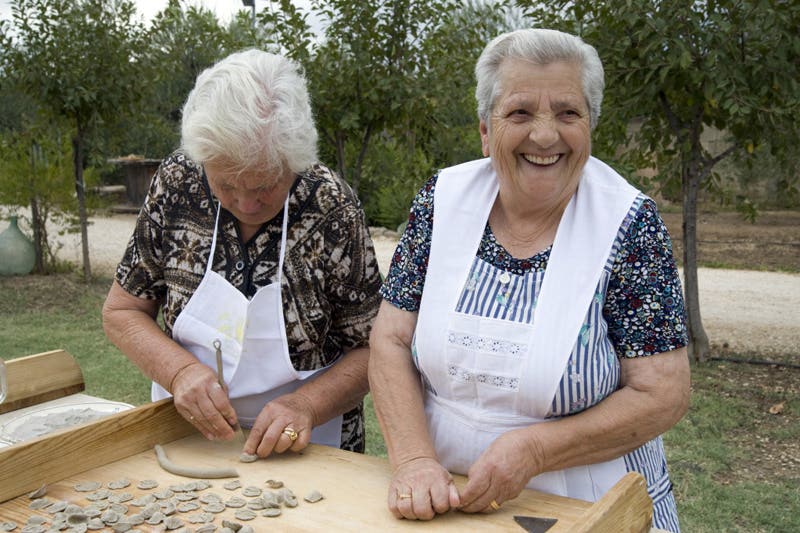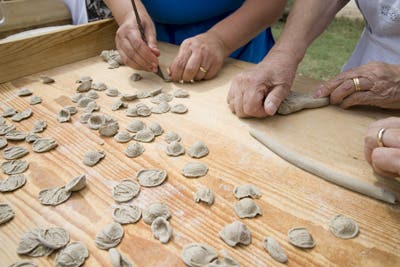
The Pasta Lesson: Making Orecchiette in Puglia
In Puglia, the heel of Italy's boot, I approached a pasta-making lesson with a combination of eagerness and anxiety.
I was eager because, as an Italian-American, I am happy to explore all things from my particularly delicious culinary heritage. And then the anxiety: A tiny finger of dread poked at me because I am, admittedly, a terrible cook. (That I come from a long tradition of family restaurant proprietorship is an added indignity.) But here in the homeland of my ancestors, surely these kindly nonne would take me to their ample, apron-wrapped bosoms and convey to me the techniques behind their ancient art. At least, I hoped they would.
While most of Italy embraces pasta, Puglia takes that love even further. The region could arguably be considered one of pasta's holy places, with many centuries-long traditions originating here. Each of the region's provinces claims a distinct pasta shape made from its own locally-grown durum wheat; each shape is designed to marry ideally with ingredients particular to its location. Some work well with seafood, others with legumes or vegetables, while everything receives a healthy dose of local olive oil.
Here, near Castel del Monte, I was going to learn the art of orecchiette ("little ears," named for their orb-like appearance), under the tutelage of two squabbling octogenarians named Dina and Maria. The small curled discs of dough work well with heartier sauces, or dishes like orecchiette con le cime di rapa (broccoli rabe), the pasta providing little scoops in which the other ingredients nestle.
We met in the garden of Antichi Sapori, a simple country restaurant owned by Pietro Zito. In addition to growing most of the ingredients for his menu, Zito uses the garden as a living laboratory to teach residents about the local food traditions he fears will be lost. The nearly four-acre garden was full of late-summer color, bursting with bright spots of tomatoes, peppers, and aubergines among the wavy vines of leafy vegetables. To one side of the plot, local women were preparing sun-dried tomatoes, while their husbands strung up fresh bright-red fruit for a long bake in the sun. And in the center of the garden was a wooden work station: the classroom for our pasta lesson.
Zito recruited the nonne, Dina and Maria, from a nearby village, but they came as well from a long tradition of street-side pasta-making in larger towns like Bari, where methods of proper dough and shaping are debated publicly and loudly. What's not arguable, however, are the ingredients: Traditional Puglian pasta is made from only flour and water. Dina and Maria bantered back and forth in Italian while preparing the wooden board upon which we'd knead, shape and cut the pasta. Working quickly and side by side, they mixed flour and water, a little at a time, measuring only by eye and monitored with an occasional friendly slap to the arm or a loud cluck. Another unofficial validation: making the sign of the cross over the dough.

Credit: Lana Bortolot
Under their hands, we kneaded the ashy dough onto a lightly floured board, formed it into small balls, and rolled it into long thin strips. Key to shaping the little ears is a flat, triangular spade with which we sliced the dough and spread the small chunks into disks that would then quickly be flipped over the top of the thumb like a cap. Watching these women work—between them, a century of pasta-making expertise—it seemed simple.
I could chop and smear, but when it came to the final maneuver, a combination of dexterity and intuition, I failed miserably. I couldn't negotiate the spade with one hand, while applying an even amount of pressure to the flattening dough disk. And forget that thumb flip: I had too many fingers in the way. The ladies guided my hands through the motions, but it became clear I'd never understand the intricacies of transforming the dough into its iconic ear shape—at least, not in the afternoon available to me. It seemed orecchiette's mystery would remain in the hands of Dina and Maria. My Italian language skills weren't quite good enough to pick up on the nuances of their corrections, but I had enough knowledge to understand the final comment of one nonna to the other as they cleaned up the table once we were through. With a shake of the head and a glance at me, she said "Lei non si sposera"—she will never get married.
Trattoria Antichi Sapori
Piazza S. Isidoro 10
Montegrosso d' Andria
+ 39/0883/569-529
Keep Reading
Continue to Next Story










